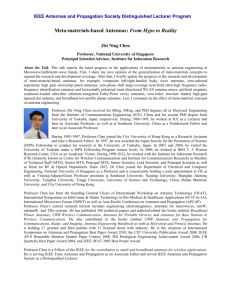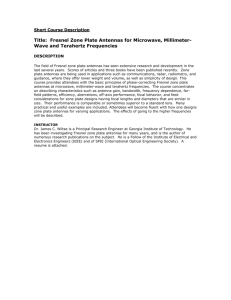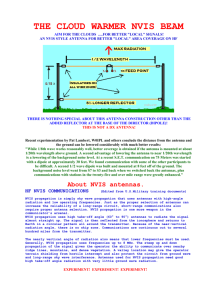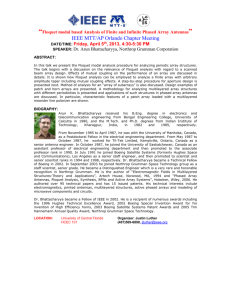Chapter 5: Antenna Arrays Antennas and Propagation
advertisement
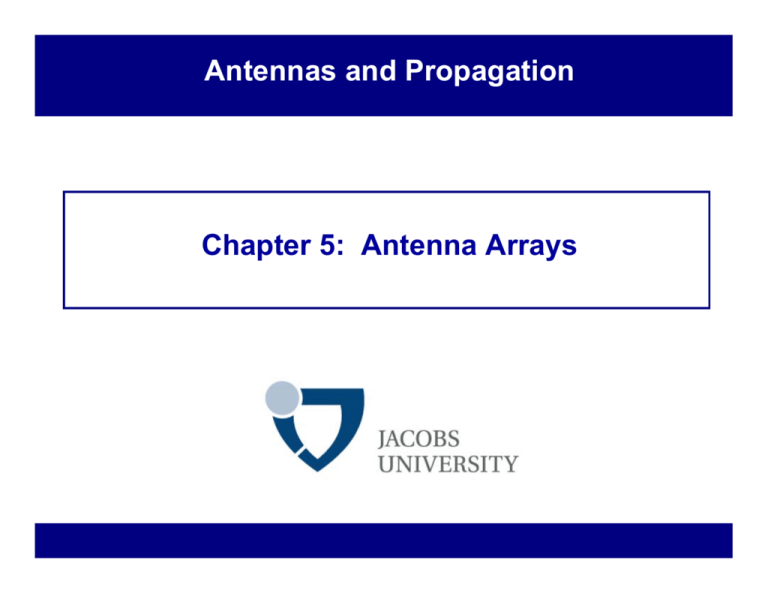
Antennas and Propagation Chapter 5: Antenna Arrays 5 Antenna Arrays Advantage Combine multiple antennas More flexibility in transmitting / receiving signals Spatial filtering Beamforming Excite elements coherently (phase/amp shifts) Steer main lobes and nulls Super-Resolution Methods Non-linear techniques Allow very high resolution for direction finding Antennas and Propagation Slide 2 Chapter 4 5 Antenna Arrays (2) Diversity Redundant signals on multiple antennas Reduce effects due to channel fading Spatial Multiplexing (MIMO) Different information on multiple antennas Increase system throughput (capacity) Antennas and Propagation Slide 3 Chapter 4 General Array Assume we have N elements pattern of ith antenna Total pattern Identical antenna elements Element Factor Array Factor “Pattern Multiplication” Antennas and Propagation Slide 4 Chapter 4 Uniform Linear Array (ULA) Place N elements on the z-axis Uniform spacing Δ Antennas and Propagation Slide 5 Chapter 4 Uniform Excitation Apply equal amplitude to elements (different phases only) Recall: Antennas and Propagation Slide 6 Chapter 4 Uniform Excitation (2) Note: sin(Nx)/sin(x) behaves like Nsinc(x) Maximum occurs for θ= θ0 Result: Steers a beam in direction θ= θ0 that has amplitude N1/2 compared to single element If we center array about z=0, and normalize “Array Gain” Normalize input power with additional elements Antennas and Propagation for θ= θ0, sin(Nx)/sin(x) goes to N Slide 7 Chapter 4 Uniform Excitation: Examples Example: N=8, Δ=λ/2 Antennas and Propagation Slide 8 Chapter 4 Grating Lobes Problem for Δ > λ/2 Lobes with amplitude equal to main beam appear Called “grating lobes” Similar to aliasing in signal processing Example Antennas and Propagation Slide 9 Chapter 4 ULA Beamwidth, Directivity Note: Example values in (.) are for N=8, Δ=λ/2 Antennas and Propagation Slide 10 Chapter 4 Hansen-Woodyard (HWA) Idea End-fire excitation has a fat main lobe Simple coherent excitation not optimal solution for directivity HWA: do direct maximization Analysis Array factor for N elements and progressive phase shift β Max max AF = 1 Antennas and Propagation Slide 11 Chapter 4 Hansen-Woodyard (2) Consider small Means scan angle on “main beam” Progressive phase shift Antennas and Propagation Slide 12 Chapter 4 Hansen-Woodyard (3) Radiation intensity: proportional to |AF|2 In beam direction, θ=0, U(θ) is Normalize U to make unity at θ=0. Call new function U′(θ) Directivity found as D0=4πUmax/Prad = Umax/U0, with How do we maximize D0? Antennas and Propagation Slide 13 Chapter 4 Hansen-Woodyard (4) Minimize Find v, then can compute β Antennas and Propagation Slide 14 Chapter 4 Hansen-Woodyard (5) vmin = -1.46 Antennas and Propagation Slide 15 Chapter 4 Hansen-Woodyard (6) Directivity of HWA: Is there a cost to increased directivity? Antennas and Propagation Slide 16 Chapter 4 Non-Uniform Excitation Increased Flexibility Weights are general Similar to a filter synthesis problem Example methods Binomial Array Similar to “maximally flat” filter No side lobes for Δ < λ/2 Tschebyscheff Array Similar to “equiripple” filter Produces smallest beamwidth for given sidelobe level Antennas and Propagation Slide 17 Chapter 4 Symmetric Array Antennas placed symmetrically on ±z axis (Also same excitation) Odd number of elements: put two copies of center element (for two sides) Amplitude on true center element is 2a1 Antennas and Propagation Slide 18 Chapter 4 Symmetric Array (2) Array factors are Example Methods Binomial array Derive based on heuristic argument Tschebyscheff array Use direct synthesis procedure Antennas and Propagation Slide 19 Chapter 4 Binomial Array 2-element Array Δ Plot of AF1 = 1 + x Has no side-lobes for Δ < λ/2 Idea to make more dir. Successively superimpose pairs of arrays Generates AF = (AF1)M Antennas and Propagation Slide 20 Chapter 4 Binomial Array (2) 2-element Array Δ 1 1 Element 1 3-element Array Δ Idea: 2-element array each element has pattern AF1 1 2 1 Element 2 Element 1 4-element Array 1 Can repeat indefinitely This procedure is just binomial series! Antennas and Propagation Δ Slide 21 3 3 1 Element 2 Chapter 4 Binomial Array (3) Coefficients Also given by Pascal’s triangle Antennas and Propagation Slide 22 Chapter 4 Binomial Array (4) Advantage No side lobes Disadvantages Wide main lobe High variation in weights Antennas and Propagation Slide 23 Chapter 4 General Array Synthesis Procedure Expand AF in a (cosine) power series AF is a polynomial in x, where x=cos u Choose a desired pattern shape (polynomial of same order) Equate coefficients of polynomials ⇒ yields weights on arrays Example Dolph-Tschebyscheff Array Solves: Minimum beamwidth for a prescribed max. sidelobe level Antennas and Propagation Slide 24 Chapter 4 Tschebyscheff Array Array factor Even number of antennas (M is twice # antennas) Cosine Power Series Antennas and Propagation Slide 25 Chapter 4 Tschebyscheff Array (2) Tschebyscheff Polynomials Recursion Direct Computation with cos/cosh Antennas and Propagation Slide 26 Chapter 4 Tschebyscheff Array (3) Tschebyscheff Polynomials Antennas and Propagation Slide 27 Chapter 4 Tschebyscheff Example M = 3 (6 antenna elements) Antennas and Propagation Slide 28 Chapter 4 Tschebyscheff Example (2) OK, but How do we map z to x? Antennas and Propagation Slide 29 Chapter 4 Tschebyscheff Example (3) Main beam at x=1 x = cos u z = z0 Let z = z0 x Antennas and Propagation Slide 30 Chapter 4 Tschebyscheff Example (4) Straightforward generalization for higher orders. Antennas and Propagation Slide 31 Chapter 4 Tschebyscheff Array (Generalized) Antennas and Propagation Slide 32 Chapter 4 Gen. Tschebyscheff Array (2) Can find the am using the same recursive procedure as before. Antennas and Propagation Slide 33 Chapter 4 Comparison of Beamforming Methods Δ=π/4, N=8, R0=10 (-20dB side lobes) Antennas and Propagation Slide 34 Chapter 4 Summary Antenna Arrays Offer flexibility over single antenna elements Array factor / Element Factor Direct synthesis methods for designing AF Beamforming Considered mainly ULA Uniform excitation (change phases) Non-uniform: Binomial array, Tschebyscheff Other possibilities Non-ULA: circular array, rectangular, sparse arrays Non-symmetric excitation Non-linear processing Antennas and Propagation Slide 35 Chapter 4

